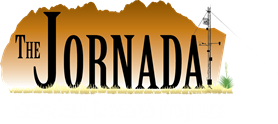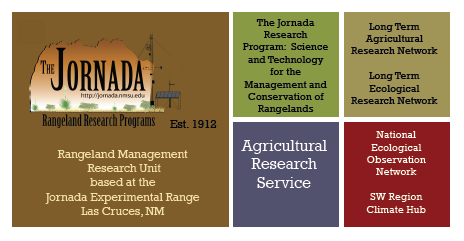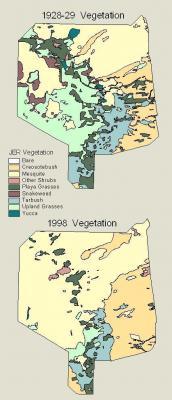Jornada Datasets: The Jornada maintains a data catalog comprised of over 150 separate, documented data sets linked to specific field studies or monitoring networks collected for different lengths of time over the course of its research history. Most completed or active data sets, and their metadata, are accessible for open public use (see Data Availability section). We are actively working towards having all data sets completely available in 2012. These data sets are organized into one of the following seven categories that generally describe their nature or intent: animal, climatic, decomposition, hydrology, intersite, plant, or soil-related. Lengths of record vary with each specific data set.
Of these, 18 data sets are separated out as truly of a long term nature. These are data sets with a minimum of 15 years of record, and are data sets that are active, on-going measurements. Many of our other data sets are also on-going, active records, but are not yet a minimum of 15 years of continuous collection. Several of these 18 long-term data sets trace back to the USFS and were initiated in 1915 and approaching a nearly 100 year record of recorded observations. These data sets (see https://jornada.nmsu.edu/data-catalogs/long-term) include classic climatic records, including daily precipitation and maximum and minimum daily air temperatures, and records of vegetation and soil surface dynamics. Of particular note are the long-term records of vegetation cover dynamics from permanent quadrats established across the Jornada in 1915, records of vegetation response to disturbances within plots established in 1938, and spatial patterns of net primary productivity established in 1989. These records are still generating insights into long term dynamics within this desert, and are published in the peer-reviewed literature (e.g., Havstad et al. 1999, Yao et al. 2005, Gibbens et al. 2005, Peters et al. 2011). In addition, all of these data are open for public use.
The Jornada also maintains an extensive catalog of spatial data. These data include GIS layers detailing boundaries, climatic networks, geographic reference points (e.g., land surveys), cultural features (e.g., roads, livestock watering points, and fences), and land coverage maps. We also provide access to satellite imagery (landsat scenes starting in 1993) as both bit map images and downloadable shape files. The Jornada also has an extensive collection of aerial photographs providing complete coverage of the Range beginning in 1935. These images have been a recent and rich source of information that have contributed to our scientific efforts (e.g., see Browning et al. 2011). Our spatial data sets are an active area of effort to provide complete and open access via web- based interactive portals, but we have not yet completed this effort. All of these spatial data sets (maps, shape files, GIS coverages) will be available in 2012.
The Jornada also has an extensive collection of historical photographs mostly collected by USDA personnel beginning in the 1920s. All of our original prints and negatives have been archived within the historical special collections within the library system at New Mexico State University to protect the original photographs. All images can be accessed through a searchable data base through the NMSU library system or on this website (see: https://jornada.nmsu.edu/jornada/photos).
Selected Bibliography: The following 10 selected papers from this Unit reflect a record of scientific activities that utilize our long-term data sets.
Peters D.P.C., Yao, J., Sala, O.E., Anderson, J. 2012. Directional climate change and potential reversal of desertification in arid and semiarid ecosystems. Global Change Biology. 18:151-163. [doi: 10.1111/j.1365-2486.2011.02498.x].
Rango, A., Havstad K.M., Estell R.E. 2011. The utilization of historical data and geospatial technology advances at the Jornada Experimental Range to support western America ranching culture. Remote Sensing. 3:2089-2109.
Browning, D.M., Laliberte A.S., Rango A. 2011. Temporal dynamics of shrub proliferation: Linking patches to landscapes. International Journal of Geographical Information Science. 25:913-930.
Yao, J., Peters D.P.C., Havstad K.M., Gibbens R.P., Herrick J.E. 2006. Multi-scale factors and long-term responses of Chihuahuan Desert grasses to drought. Landscape Ecology. 21:1217-1231.
Peters, D.C., Mariotto I., Havstad K.M., Murray L.M. 2006. Spatial variation in remnant grasses after a grassland-to-shrubland state change: Implications for restoration. Rangeland Ecology and Management. 59:343-350.
Gibbens, R.P., McNeely R.P., Havstad K.M., Beck R.F., Nolen B. 2005. Vegetation changes in the Jornada Basin from 1858 to 1998. Journal of Arid Environments. 61:651-668.
Goslee, S.C., Havstad K.M., Peters D.C., Rango A., Schlesinger W. 2003. High-resolution images reveal rate and pattern of shrub encroachment over six decades in New Mexico, USA. Journal of Arid Environments. 54:755-767.
Havstad, K.M., Gibbens R.P., Knorr C.A., Murray L.W. 1999. Long-term influences of shrub removal and lagomorph exclusion on Chihuahuan Desert vegetation dynamics. Journal of Arid Environments. 42:155-166.
Gibbens, R.P., Beck R.F. 1988. Changes in grass basal area and forb densities over a 64-year period on grassland types of the Jornada Experimental Range. Journal of Range Management. 41:186-192.
Gibbens, R.P., Tromble J., Hennessy J.T., Cardenas M. 1983. Soil movement in mesquite dunelands and former grasslands of southern New Mexico from 1933 to 1980. Journal of Range Management. 36:145-148.
Global Datasets: For the past several years the Jornada has led an effort to collect datasets from 50 participating research sites and field stations mostly across North America. The effort, termed the EcoTrends Project, was designed to promote and enable the use and synthesis of long-term data to examine trends in the Earth's ecosystems. The EcoTrends project is a collaborative effort among state and federal agencies and institutions to make long-term ecological data easy to access, analyze, and compare within and across sites. The EcoTrends website is a portal to:
- a large and diverse collection of standardized long-term ecological datasets and their metadata (> 1200 datasets)
- unique data exploration, downloading, graphing and synthesis tools
- information about participating research sites and their parent agencies
These datasets, tools, and information are available to anyone who would like to view trends in ecological variables for one or multiple sites or pursue additional statistical analyses of within-site and cross-site comparisons. A synthesis text on this project and detected trends from these data is in press:
Peters, D.P.C., Laney C.M., Lugo A.E., Collins S.L., Driscoll C.T., Groffman P.M., Grove J.M., Knapp A.K., Kratz T.K., Ohman M.D., Waide R.B. and Yao J. 2013. Long-term trends in ecological systems: A basis for understanding responses to global change. USDA Agriculture Research Service, Technical Bulletin No. 1931. Washington, D.C.




